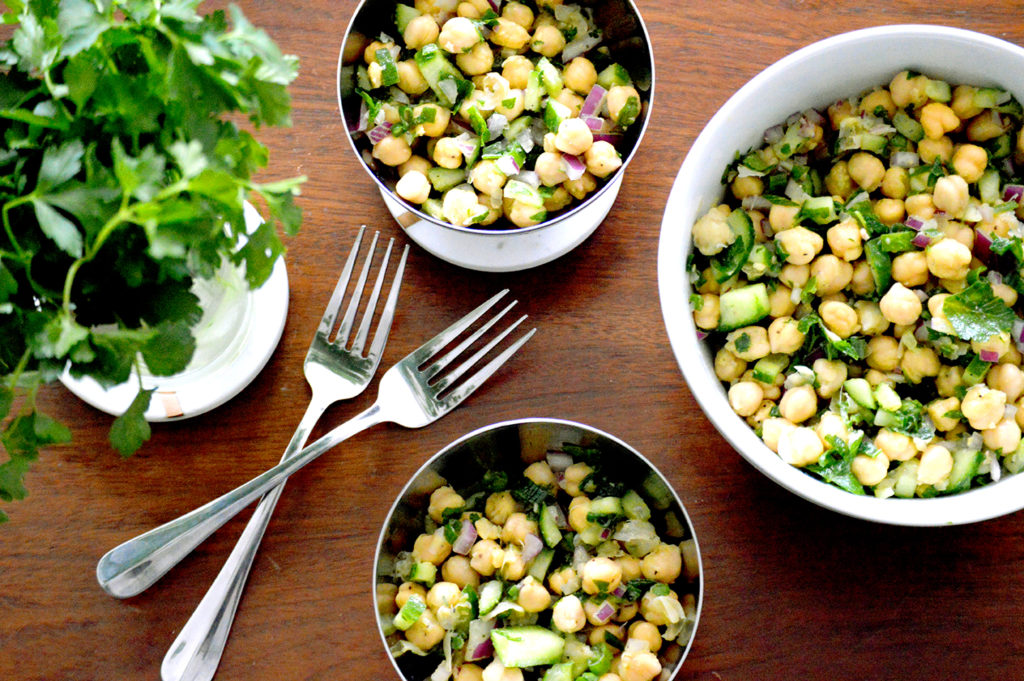
This article originally appeared in the March 2020 edition of Senior Scope. Article and photo by Seth Thomas.
Many of the popular dietary guidelines out there today – like the Mediterranean and DASH diets – call for a reduction in sodium, and that’s because consuming less can help reduce your blood pressure. However, avoiding sodium can be a challenging task given how frequently the ingredient is used to flavor foods.
During a recent presentation at the Dartmouth Council on Aging, Katlynn Ferreira, a registered dietitian with Coastline, prepared a simple chickpea salad that demonstrated that you don’t have to sacrifice flavor when cutting back on sodium.
The American Heart Association recommends a maximum of 2,300 milligrams (mg) of sodium a day, with an ideal limit of 1,500 mg per day. For context, one teaspoon of table salt, which is a combination of sodium chloride and other additives, contains about 2,300 mg of sodium.
By swapping table salt for fresh herbs, dried spices and other ingredients, Ferreira created a low-sodium snack that can easily be modified into a meal.
As she assembled the dish, she offered some general advice for heart-healthy cooking.
Be critical of low-sodium claims:
While perusing the shelves at the grocery store, you will see plenty of marketing buzzwords on food labels. But context is everything.
Ferreira said she recently looked at two brands of organic chicken stock that claimed to be “low-sodium.” Rather than relying on this vague claim on the front of the box, she scanned the Nutrition Facts label for more precise information. Both brands had a similar serving size, but one brand contained more salt per serving than the other.
“Sodium is in so many foods. If you can cut back here and there, it will help a lot,” said Ferreira.
Fiber-rich foods help your heart:
Many of the ingredients in Ferreira’s recipe – chickpeas, cucumbers and even the parsley – contain fiber, which can help lower levels of “bad” cholesterol (LDL).
Eating a fiber-rich diet also helps you feel fuller on fewer calories, which can help control weight gain. You can add more fiber to your diet by selecting whole-grain options at the grocery store and incorporating more fruits and vegetables into your favorite recipes.
That goes for the chickpea salad, too. Ferriera’s chickpea salad recipe (available at the end of this article) can become a base for other ingredients, such as cherry tomatoes, broccoli, celery, different kinds of beans or tuna. But, be mindful of adding ingredients high in salt.
Herbs add flavor without salt:
Herbs can do more than garnish your plate. The chickpea salad was flavorful, and that had a lot to do with fresh, chopped parsley.
“Cooking with fresh herbs can help us get rid of the salt shaker when we’re cooking,” said Ferreira. “Instead of seasoning foods with salt, or a seasoning packet that may be high in salt, you can flavor foods with herbs.”
If eliminating salt completely proves too difficult, you can incorporate some salt into a dish through other ingredients that provide other nutrients. For instance, the chickpea salad Ferreira prepared had a sprinkling of feta cheese. But a little goes a long way.
Chickpea Salad
2 (15 ounce) cans of low-sodium chickpeas
1 small red onion, diced
1 cup cucumber, diced
½ cup thinly sliced scallions
1 cup fresh chopped parsley
1 ½ tablespoons olive oil
2 tablespoons of lemon juice
1 teaspoon garlic powder
A sprinkling of feta cheese
- Drain and rinse chickpeas and place in a large bowl
- Add red onion, scallions, cucumbers, parsley, olive oil, and lemon juice, then mix.
- Season with garlic powder, salt and pepper. Add other ingredients, like feta, to taste.


Recent Comments